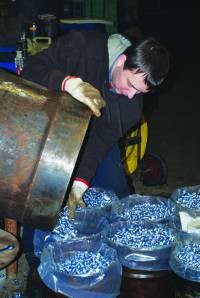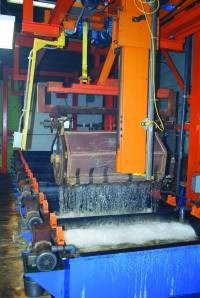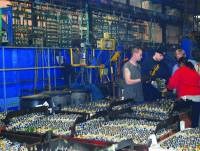Old Plant, New Process
Novel zinc chemistry increases throughput at Elyria Plating
Elyria, OH, is a blue collar kind of town. Located about 25 miles southwest of Cleveland, the city grew up on manufacturing and, despite tough times in many industries, remains home to many foundries, metal fabricating shops and other assorted heavy manufacturing companies. Companies such as Ridge Tool call Elyria home, and many others operate local manufacturing facilities.
Elyria Plating Corp. certainly qualifies as part of Elyria’s industrial fabric. In business since 1937, the company has been home to multiple generations of employees from some families.
A case in point is Eric Manuel, the current plant manager, whose father has worked for Elyria Plating for more than 50 years and has no intention of retiring. “For some people, plating is in your blood,” Manuel explains. “We have other employees here like that, too.”
Currently operating out of a 60,000 ft2 shop with 37 employees, Elyria Plating provides multiple finishing services. The company offers processes ranging from electroless nickel and sulfuric acid anodizing to electrolytic tin, silver and nickel; passivation and both hex- and trivalent chromate; and cadmium plating.
“Our cadmium plating capability is kind of a good thing, because basically almost no one does that any more,” Manuel says. “Customers for cadmium plating are almost strictly military.”
About 40% of the company’s business is automotive-related, but customers include names such as Briggs & Stratton, Parker Hannifin and Lincoln Electric. “We’re pretty diverse, and right now business is staying steady,” Manuel explains. “Parts may come in by the semi-load and they may come in someone’s car trunk. Either way, we try to accommodate everyone.”
Despite the variety of processes, Elyria Plating’s bread and butter has always been zinc electroplating. The company operates multiple automatic zinc electroplating lines in both barrel and rack configurations, plus a couple of manual lines for smaller jobs.
The company’s plant may be old, but that doesn’t mean that its processes have remained the same. Take wastewater treatment, for example. “We just built a new wastewater system a couple of years ago,” Manuel says. “We worked with a local company on the design and did the fabrication and installation work ourselves. It’s stainless, and it handles a lot of water.”
According to Manuel, Elyria Plating is working on splitting its waste streams with an eye toward deregulating its filter cake. “We have two separate wastewater systems, with probably an 80/20 split on the streams,” he explains. “We’re trying to push all of our zinc and tin lines and trivalent chromates through the large system. On the smaller system, we run all our hexavalent rinses, which we use very little any more, and cadmium and nickel rinses.
Currently wastewater from both streams is processed through the same filter, and the resulting cake must be treated as hazardous and hauled away at a cost of $170–$200/ton. “What we’d like to do is use a smaller filter system for the hazardous stuff and get the majority of the sludge deregulated,” Manuel says.
Barrel Zinc Improvement
Another area that recently came in for process improvement is barrel zinc plating. Until recently, all the zinc lines—regardless of size, whether barrel or rack— used conventional acid chloride chemistries from various suppliers. But a chemistry switch a few month ago in Elyria Plating’s automatic return barrel zinc line has resulted in some substantial gains in throughput and other benefits.
Elyria Plating moved from conventional acid chloride in the barrel zinc line to a new zinc chemistry called SmartZinc (see sidebar). According to Manuel, the conversion was a simple matter of making additions with the new chemistry until the changeover was completed. “We just started to use the new chemistry and let it convert over naturally,” he says. “We didn’t have to dump the old bath or anything like that.” All other processes on the line, including cleaning, passivating and sealing, remained the same.
Supplied by Pavco Inc. (Charlotte, NC), SmartZinc operates in a way that is different than conventional zinc chemistries. “With a conventional acid chloride bath, if it’s 95° outside, the bath can get too hot,” Manuel explains. “If that happens, it just quits plating. You’re done, and there’s nothing to do but shut the line down. We used to run chillers to keep it cool.
“With the SmartZinc, we actually have to put some heat into it,” he continues. “The startup temperature is 120°, so we pulled the chiller coils out of the tanks and put steam coils in.”
According to Manuel, the new chemistry has enabled a throughput increase of at least 30–40% on the barrel line. The added throughput is especially apparent when plating parts that require a thicker zinc deposit.
“Some of the plugs and other parts we run require 0.0005–0.0007 inch of plating thickness,” he explains. “To get a deposit that thick before on this barrel line, we’d have to get the barrels in the tanks, shut the line down and wait 25–30 min or longer with the rectifier on to get it to plate to the needed thickness. Then we’d do the same thing with the next batch of barrels. Now, if we run the SmartZinc at 110°, we might stop for 5 min, but we can pretty much run the line without stopping.”
Each barrel can handle loads weighing up to 450 lb. “It depends a lot on the part configuration,” Manuel says. “On the barrel line, you’re either running 450 lb or 100 lb. The challenge is keeping a steady flow and schedule the jobs in the right order. You can’t just grab parts and chuck them in a barrel, because some parts just don’t go together. If you don’t do it right, you could overplate or underplate and then you have a potential quality issue.”
Maintaining Quality
According to Elyria Plating quality manager Bob Ridenour, parts plated using the new process meet various specifications for coating thickness and other characteristics.
“For example, we plate these small engine plugs on that line,” Ridenour says, picking up what looks like an oil drain plug for a small engine. “A barrel holds about 30,000 pieces, and they need a deposit thickness of 0.0002–0.0004 inch. Before, we had to stop the line 30 min every time to plate them. Now we don’t stop at all, and we average 0.00025-inch plating thickness. And now that we can run the parts and not stop, there’s also a lot less thread damage and fewer worries about bad parts.”
According to Ridenour, the hotter the process gets the faster it plates, up to an upper temperature limit of about 150°. “If we run it in the 120° range, we can even do parts that require 0.0005–0.0007 inch deposit thickness without stopping,” he says. “We’re running now at about 110°, but we can run at ambient temperature and still get the same adhesion, quality, and deposit thickness.”
Elyria Plating uses X-ray fluorescence in the lab to verify coating thickness. Chemistry control is via daily titrations and additions, but the XRF machine can also come in handy for maintaining and troubleshooting plating baths, Ridenour says. “We use it sometimes to check metals content in the baths, and it can also help us pick up metal contaminants in the baths.”
The company’s lab also houses a salt-spray test chamber, which gets a workout just ensuring that fasteners and other zinc-plated components for suppliers of General Motors can pass the automaker’s GMW 3044 standard for zinc plating. “For GM, three pieces per line per shift have to pass their salt-spray specification, which calls for a minimum of 120 hr to white rust and 240 hr to red rust,” Ridenour says.
Manuel believes improved throughput on the barrel zinc line has been an important part of Elyria Plating’s drive to keep customers coming back—a key part of the company’s operating philosophy. “Turnaround times are just-in-time,” he says. “Customers want to drop parts off in the morning and then pick them up the same afternoon. Or they’ll call and say, ‘We’re bringing you parts tomorrow, when will we be able to pick them up?’ So sometimes the parts aren’t even here yet and they’re calling wanting to know when they’ll be ready.
“And you just do the best you can to keep them happy and they’ll keep coming back,” he concludes. “It all comes down to keeping customers happy.”
Read Next
Education Bringing Cleaning to Machining
Debuting new speakers and cleaning technology content during this half-day workshop co-located with IMTS 2024.
Read MoreA ‘Clean’ Agenda Offers Unique Presentations in Chicago
The 2024 Parts Cleaning Conference, co-located with the International Manufacturing Technology Show, includes presentations by several speakers who are new to the conference and topics that have not been covered in past editions of this event.
Read MoreEpisode 45: An Interview with Chandler Mancuso, MacDermid Envio Solutions
Chandler Mancuso, technical director with MacDermid Envio discusses updating your wastewater treatment system and implementing materials recycling solutions to increase efficiencies, control costs and reduce environmental impact.
Read More
















.jpg;maxWidth=300;quality=90)







